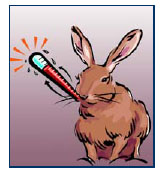What’s Growing in Your Rabbit? – Treating Bacterial Infections

Your bunny has a runny nose or a painful swollen abscess. When you return from the vet with antibiotics and instructions to medicate your sulking rabbit, be sure that you have the correct medicine and are using it as directed. Antibiotics are invaluable in helping a body heal, but the wrong drug can harm by delaying proper treatment or causing illness.
An infection in rabbits is often treated empirically, meaning that an educated guess is made about which antibiotic will most likely be effective. This saves money only if the educated guess is correct. Ideally, every infection would be cultured, meaning that a sterile swab is taken, inserted into the infected area and sent out to a lab. At the lab, the swab is wiped across a bacterial growth medium and the type of bacteria that is growing is identified. Little paper discs, impregnated with different antibiotics, are dropped on the bacterial lawn. Those discs that kill the bacteria near them are hoped to have the same effect in the body as in the lab dish. The culture and sensitivity report will state the bacteria grown from the sample and list antibiotics that they are sensitive or resistant to.
Using the wrong antibiotic to treat an infection wastes valuable time and money. If bacteria are not sensitive to an antibiotic at the dose used, the bacteria will continue to grow and cause illness, or hide in the body to cause later infection. Indiscriminate use of an antibiotic also causes bacterial resistance because the surviving bacteria have had the chance to develop strategies to combat the drug. For instance, antibiotics given for viral illness will never affect the virus and will only lead to surviving resident bacteria evading the drug next time. You can prevent resistance by using antibiotics only at the recommended dose for the required amount of time – no skipping/reducing doses or leftover drug!
Because of the sensitive gastrointestinal tract of rabbits, a limited number of antibiotics are safe to use for this species. A first-line drug is trimethoprim sulfa (Tribrissen), which interferes with bacterial folate metabolism. It is very inexpensive and very effective if the bacteria are sensitive to it. Another commonly used drug is enrofloxacin (Baytril), a fluoroquinolone type drug that prevents bacterial DNA from coiling correctly. However, Baytril is expensive and overused to the point that more bacteria are becoming resistant to it. Chloramphenicol or the sister compound florfenicol (NuFlor, ironically licensed only for non-lactating dairy cattle) are also very effective antibiotics that work on bacterial ribosomes. Antibiotics to avoid for rabbits include penicillin, cephalosporins, and clindamycin. These antibiotics will usually kill the bacteria causing infection, but will also destroy the gut flora of the rabbit and result in an often fatal colitis.
We live in a sea of bacteria. Most are harmless, some only cause illness in those whose immune systems aren’t functioning well, and a few others will cause disease if we are exposed to them in large enough doses. Antibiotics help kill the bacteria that the body’s immune system is not able to control and eliminate. Please help your vet use these invaluable drugs wisely.
by Astrid Kruse
